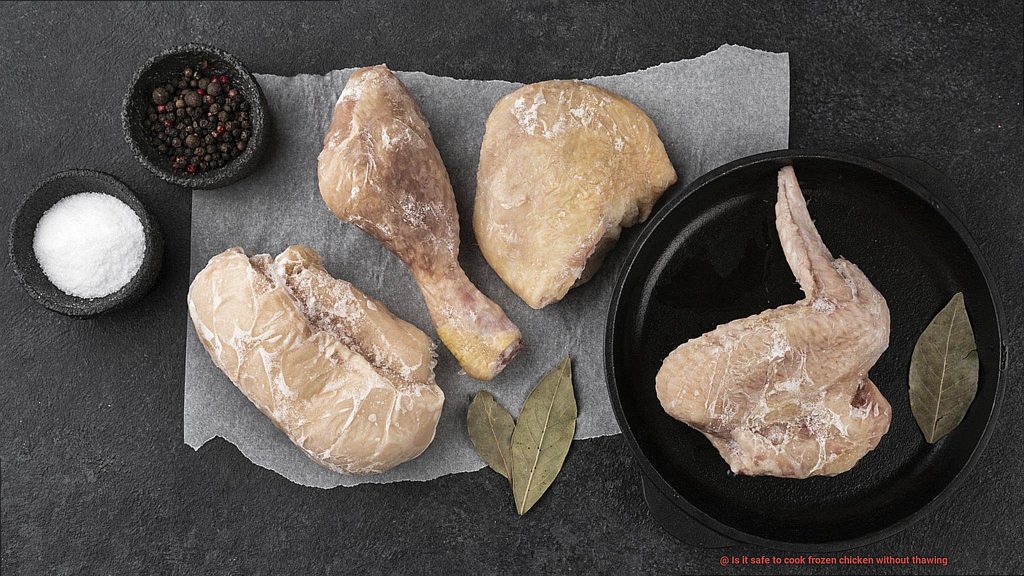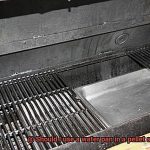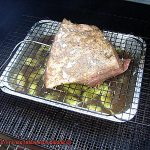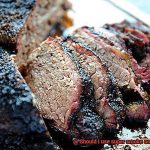Imagine this: it’s a hectic weeknight, you’re pressed for time, and you’ve completely forgotten to thaw your chicken for dinner. Your heart races as you wonder if cooking the chicken from frozen is safe and will still result in a scrumptious meal. This is a common predicament that many home chefs face. But don’t fret, because we have the answer to the age-old question: can you cook frozen chicken without thawing it first?
The short answer is yes, you absolutely can cook frozen chicken without thawing it in advance. However, there are some crucial factors to keep in mind. Firstly, cooking frozen chicken requires more time and attention to ensure that it reaches an internal temperature of at least 165°F – the recommended safe temperature for poultry. Additionally, cooking frozen chicken may lead to a less tender and juicy texture compared to cooking defrosted chicken.
But why is it safe to cook frozen chicken directly? The answer lies in the fact that bacteria growth is halted at low temperatures. Freezing chicken puts it on hold – essentially putting any bacterial growth on pause. Therefore, when you cook frozen chicken properly, any existing bacteria will be killed off.
In this article, we’ll delve deeper into the nitty-gritty details of cooking frozen chicken – including tips and tricks for success with different methods such as baking or grilling. So if you’ve ever found yourself in a bind with frozen poultry on hand, read on for all the essential information you need.
Contents
Is It Safe to Cook Frozen Chicken Without Thawing?
The answer is yes, but it’s essential to take some necessary safety measures to prevent any health risks.
Firstly, cooking frozen chicken takes longer than cooking thawed chicken. The reason being, the heat needs to penetrate through the frozen meat before it can properly cook the inside. Be patient and adjust your cooking time accordingly to ensure that your chicken is cooked through.
Secondly, a safe internal temperature of 165°F (74°C) is crucial when consuming chicken. This temperature kills any harmful bacteria that may be present in the chicken. To determine the temperature, use a meat thermometer and check the internal temperature at the thickest part of the meat.
Thirdly, cross-contamination can be a potential risk when handling raw chicken. To avoid it, wash your hands thoroughly before and after handling the chicken, use separate cutting boards and utensils for raw and cooked foods, and store the chicken at a safe temperature in the freezer until ready to use.
Lastly, to avoid overcooking the outside of your frozen chicken while the inside remains raw, consider using a lower heat setting and covering the chicken while it cooks to help distribute the heat evenly.
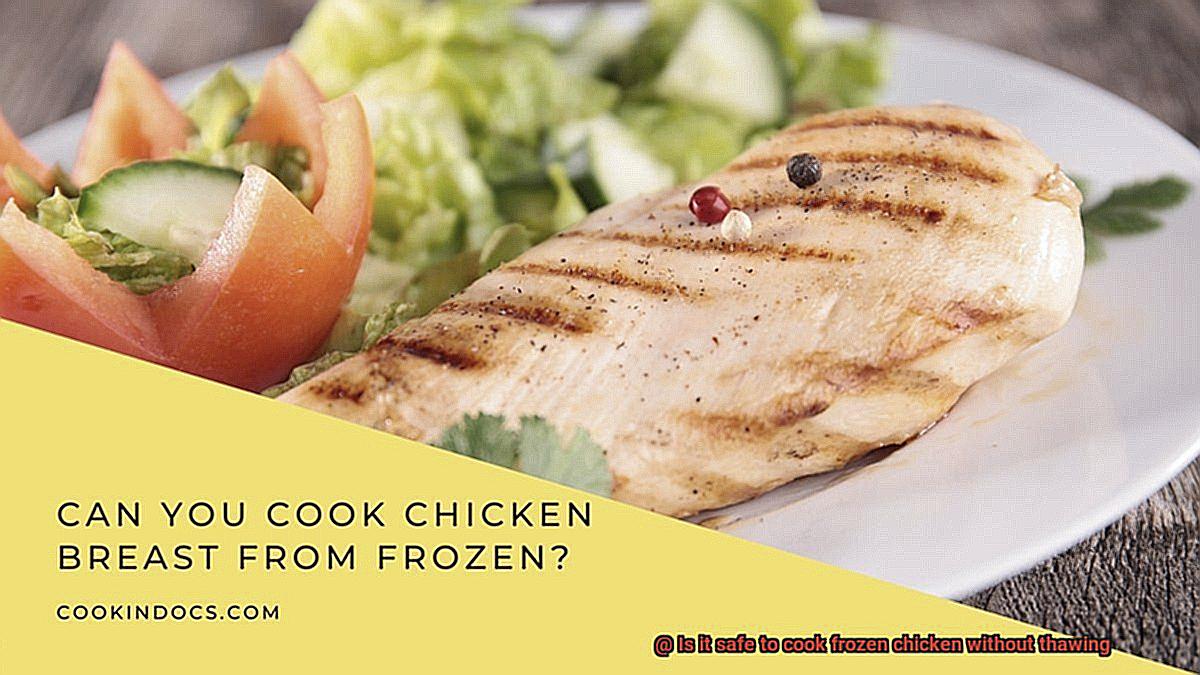
Benefits of Cooking Frozen Chicken Without Thawing
Cooking frozen chicken without thawing it can actually be a game-changer. As an expert in this matter, I can confidently tell you that there are several benefits to cooking frozen chicken straight from the freezer. Let’s take a closer look at why.
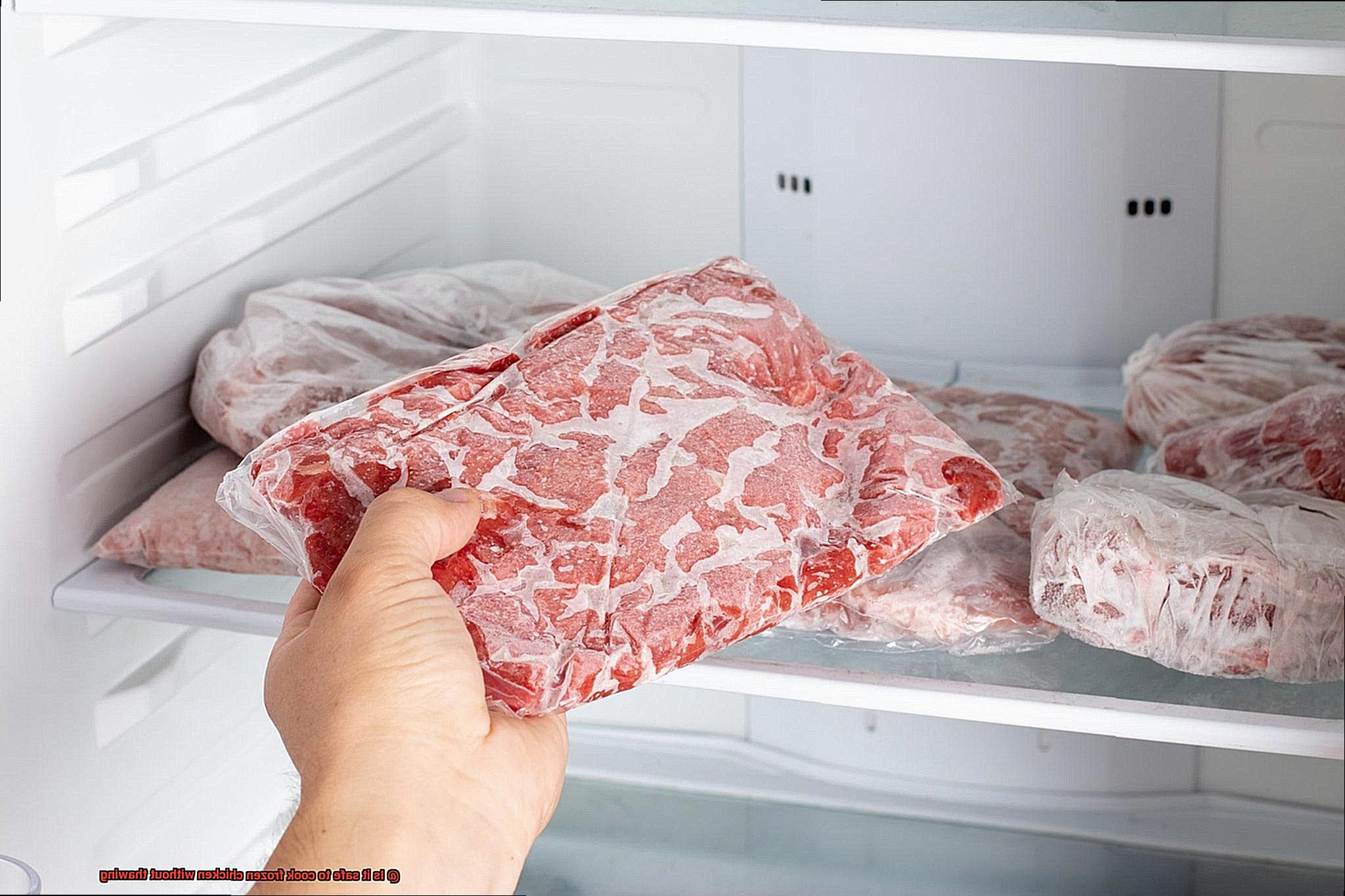
Firstly, let’s talk about time-saving. Thawing chicken can be a tedious process that requires planning ahead. But when you cook frozen chicken, you can skip the thawing process altogether and get dinner on the table faster. This is perfect for busy weeknights or when you’re short on time and need a quick meal.
But wait, there’s more. Did you know that cooking frozen chicken without thawing it can actually help to retain moisture in the meat? When you thaw chicken, the ice crystals that form during freezing melt and can cause the meat to release some of its moisture. By cooking frozen chicken, you can avoid this loss of moisture and end up with juicier, more flavorful meat. Who doesn’t want that?
Moreover, cooking frozen chicken without thawing it can be safer than thawing first. When you thaw chicken, bacteria can grow on the surface of the meat if it is not thawed properly or kept at a safe temperature. By cooking frozen chicken straight from the freezer, you can reduce the risk of bacterial growth and ensure that your meal is safe to eat.
To summarize, here are the benefits of cooking frozen chicken without thawing it:
- Saves time
- Retains moisture in the meat for juicier and more flavorful chicken
- Reduces the risk of harmful bacterial growth
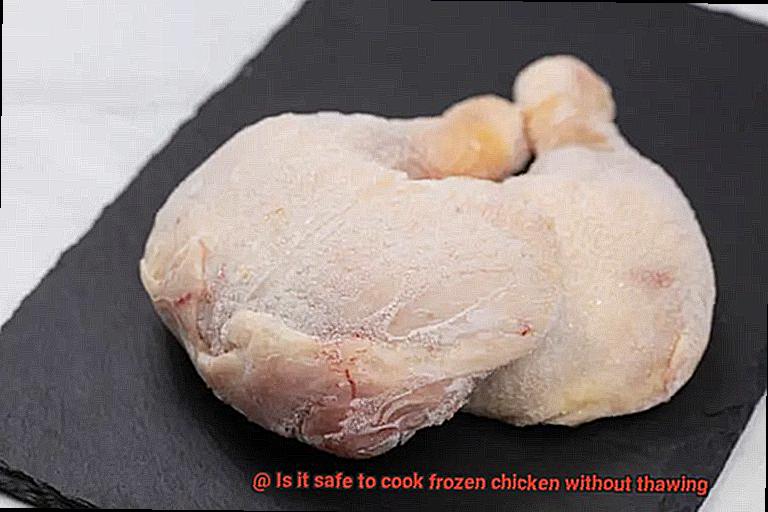
Potential Risks of Cooking Frozen Chicken Without Thawing
Firstly, it’s important to note that frozen chicken takes longer to cook than thawed chicken. This means that the outside of the chicken may burn or become overcooked while the inside remains undercooked. Not only is this unpleasant for your taste buds, but it also poses a higher risk of foodborne illness as harmful bacteria can survive in undercooked areas.
Moreover, uneven distribution of heat throughout the meat can create certain areas that remain at an unsafe temperature for too long, allowing bacteria to grow and multiply. Plus, cooking frozen chicken can cause excess water to be released from the meat, leading to a loss of flavor and texture. When ice crystals form within the meat during freezing, they can damage muscle fibers and result in them breaking down when cooked.
Lastly, cooking frozen chicken can be dangerous if not done properly. For instance, using a grill can result in excess water being released from the meat and causing flare-ups, which can lead to a fire. Extra safety precautions should be taken when cooking frozen chicken, such as using a meat thermometer to ensure that all areas reach an internal temperature of at least 165°F (74°C).
How to Prepare Frozen Chicken for Cooking
Frozen chicken can be a lifesaver when you’re short on time and need to whip up a meal quickly. However, it’s important to take certain steps to ensure that the chicken is safe to eat and cooked to perfection. Here are some tips and precautions to keep in mind when preparing frozen chicken for cooking.
Proper Storage
Frozen chicken should be stored at 0°F or lower to prevent bacterial growth and foodborne illness. Make sure it’s properly sealed and stored in the freezer until ready to use. Don’t leave it at room temperature for more than two hours.
Thawing Methods
The best way to prepare frozen chicken for cooking is by thawing it in the refrigerator overnight or using the defrost function on your microwave. Avoid thawing at room temperature as this can increase the risk of bacteria growth. If you need to cook frozen chicken without thawing it first, use a lower cooking temperature for a longer period of time or use a sous vide machine.
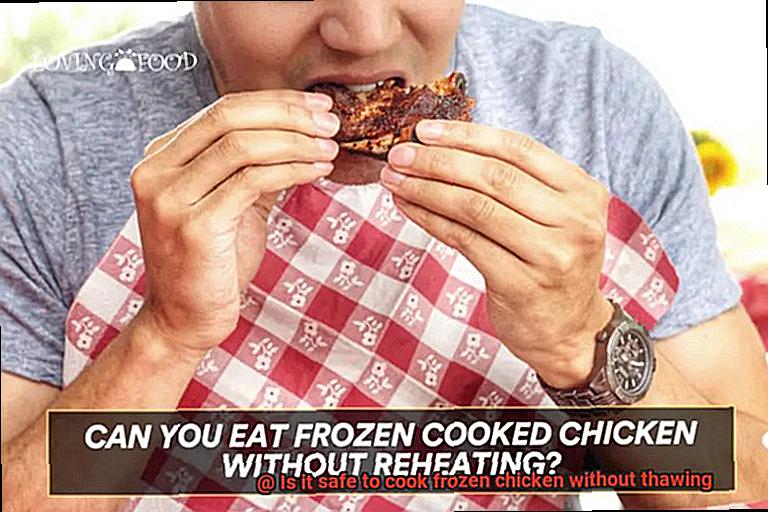
Rinse and Season
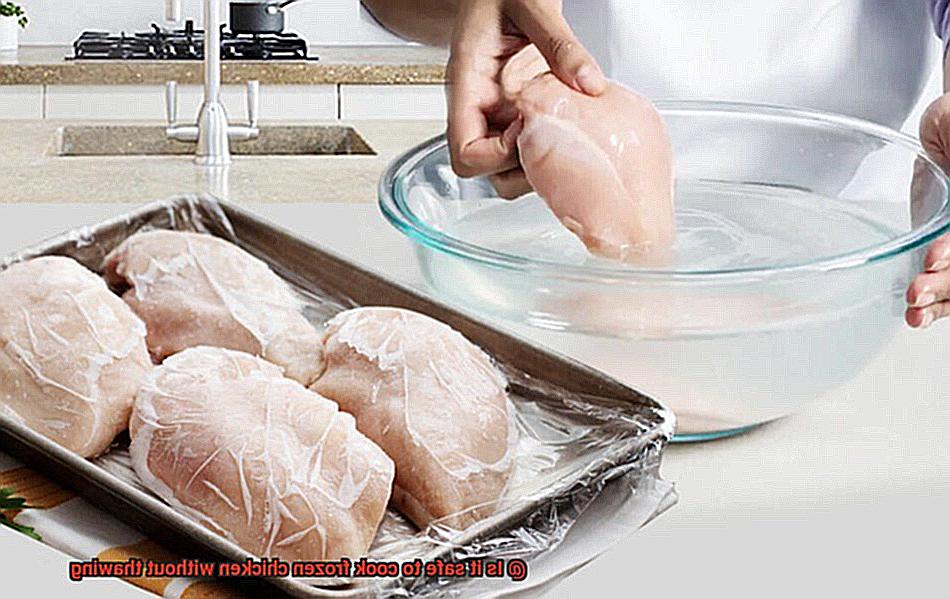
Before cooking frozen chicken, remove any packaging or wrapping and rinse it under cold water to remove ice crystals and excess moisture. Pat it dry with paper towels and season it with your desired spices and seasonings. This helps enhance the flavor and ensures even seasoning throughout.
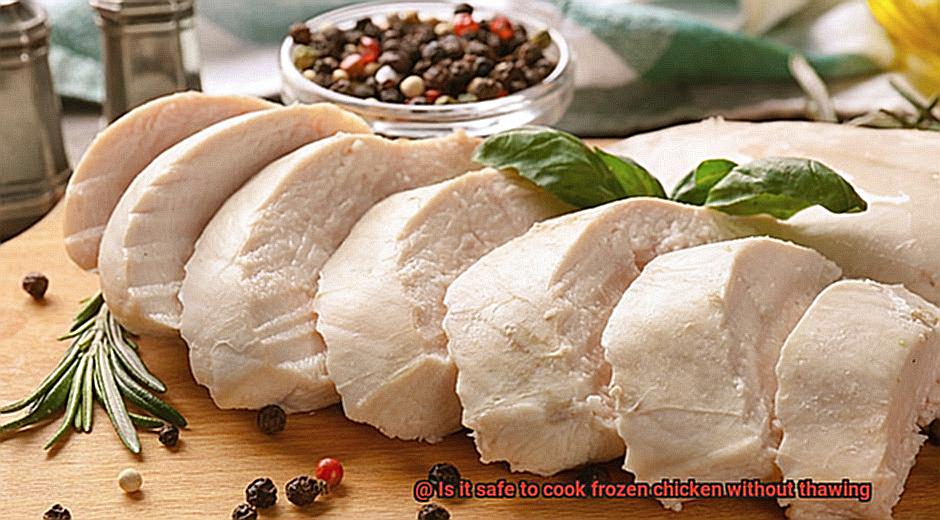
Cooking Methods
There are several methods for cooking frozen chicken, including baking, grilling, and frying. Regardless of the method used, make sure the internal temperature reaches 165°F (74°C) to ensure it’s safe to eat. Use a meat thermometer to check the temperature.
Precautions
When handling frozen chicken, wash your hands thoroughly before and after handling it. Use separate cutting boards and utensils for raw and cooked foods to prevent cross-contamination. Store the chicken at a safe temperature in the freezer until ready to use.
The Best and Safest Methods for Cooking Frozen Chicken
Cooking frozen chicken is still an option, but it’s important to use the best and safest methods to ensure that your food is both delicious and free from harmful bacteria. As an expert on the subject, I’m here to share with you the top methods for cooking frozen chicken.
First on the list is the trusty slow cooker. This method is perfect for busy people who want to set it and forget it. Place your frozen chicken in the slow cooker and let it cook slowly and evenly until it reaches an internal temperature of 165 degrees Fahrenheit. The result? Tender, juicy chicken that’s cooked to perfection.
If you’re more of a fan of oven-baked chicken, you’ll be happy to know that this method works great for frozen chicken too. Preheat your oven to 375 degrees Fahrenheit, place your frozen chicken in a baking dish, and bake it for about 45 minutes or until it reaches an internal temperature of 165 degrees Fahrenheit. The oven’s dry heat will cook the chicken evenly, resulting in a golden brown crust that’s crispy on the outside and juicy on the inside.
Now, if grilling is more your style, you can still cook frozen chicken that way too. However, it’s crucial that you take extra precautions to ensure that it’s cooked safely. One way to do this is by partially thawing the chicken before grilling. Place your frozen chicken in a sealable plastic bag and submerge it in cold water, changing the water every 30 minutes until the chicken is partially thawed. Once partially thawed, season your chicken and grill it over medium heat until it reaches an internal temperature of 165 degrees Fahrenheit. The grill will give your chicken a smoky flavor that will make your taste buds dance with joy.
No matter which method you choose, always follow proper food safety guidelines such as storing your frozen chicken at 0°F or lower, thawing in the refrigerator or microwave, and practicing good hygiene when handling it. And of course, use a meat thermometer to ensure that your chicken is fully cooked. Don’t risk serving undercooked chicken that can lead to food poisoning.
Tips for Ensuring Safe Internal Temperatures When Cooking Frozen Chicken
When cooking frozen chicken, one of the most important things to keep in mind is ensuring that the chicken reaches a safe internal temperature of 165°F (74°C) to avoid the risk of foodborne illness. Here are some tips to help you achieve this:
Use a Meat Thermometer
This is the most accurate way to check if the chicken has reached a safe temperature. Make sure to insert the thermometer into the thickest part of the meat, avoiding any bones or fat, and check it at multiple points throughout the cooking process.
Cook on a Lower Heat Setting
Cooking frozen chicken on high heat may result in an unevenly cooked chicken with an undercooked center and overcooked exterior. It’s best to cook on a lower heat setting for a longer duration to allow the chicken to cook through without burning on the outside.
Use a Marinade or Seasoning
A marinade or seasoning can help add flavor and moisture to the chicken, as well as aid in even cooking. Marinades that contain acidic ingredients like lemon juice or vinegar can help break down proteins in the chicken, making it easier to cook evenly. Salt-based seasonings can help keep the chicken moist during cooking.
Choose an Even Heat Distribution Method
Grilling or baking is an excellent way to ensure even heat distribution around the chicken, which helps cook it thoroughly without drying it out. On the other hand, methods like pan-frying or microwaving may not distribute heat evenly throughout the chicken, leading to hotspots and undercooked areas.
Allow Enough Time for Cooking
Frozen chicken typically takes longer to cook than thawed chicken, so plan ahead and allow enough time for it to cook fully before serving. If you’re unsure when it’s done, use a meat thermometer to check its internal temperature at multiple points.
Common Mistakes to Avoid When Cooking Frozen Chicken
While cooking frozen chicken can be a convenient option, there are some common mistakes that people make that can lead to unsafe or unappetizing meals. As an expert on the topic, I’m here to share with you the four most important things to keep in mind to avoid these mistakes and ensure that your meal is both safe and delicious.
Firstly, it’s crucial to properly season or marinate the chicken before cooking. While it’s possible to cook frozen chicken straight from the freezer, seasoning or marinating will add flavor and help tenderize the meat.
Secondly, don’t be tempted to cook at too high of a temperature. Although it can be tempting to crank up the heat for quicker cooking times, this can lead to uneven cooking, with the outside being overcooked and the inside raw. It’s best to cook frozen chicken at a lower temperature for a longer period of time.
Thirdly, always use a meat thermometer to check the internal temperature of the chicken. This is important for all meats, including frozen chicken. Relying on visual cues alone can be risky, so make sure the internal temperature reaches 165°F before serving.
Lastly, don’t overcrowd the pan when cooking frozen chicken. Each piece needs enough space on the pan or grill to ensure even cooking and safe meat. Overcrowding leads to uneven cooking and potentially unsafe meat.
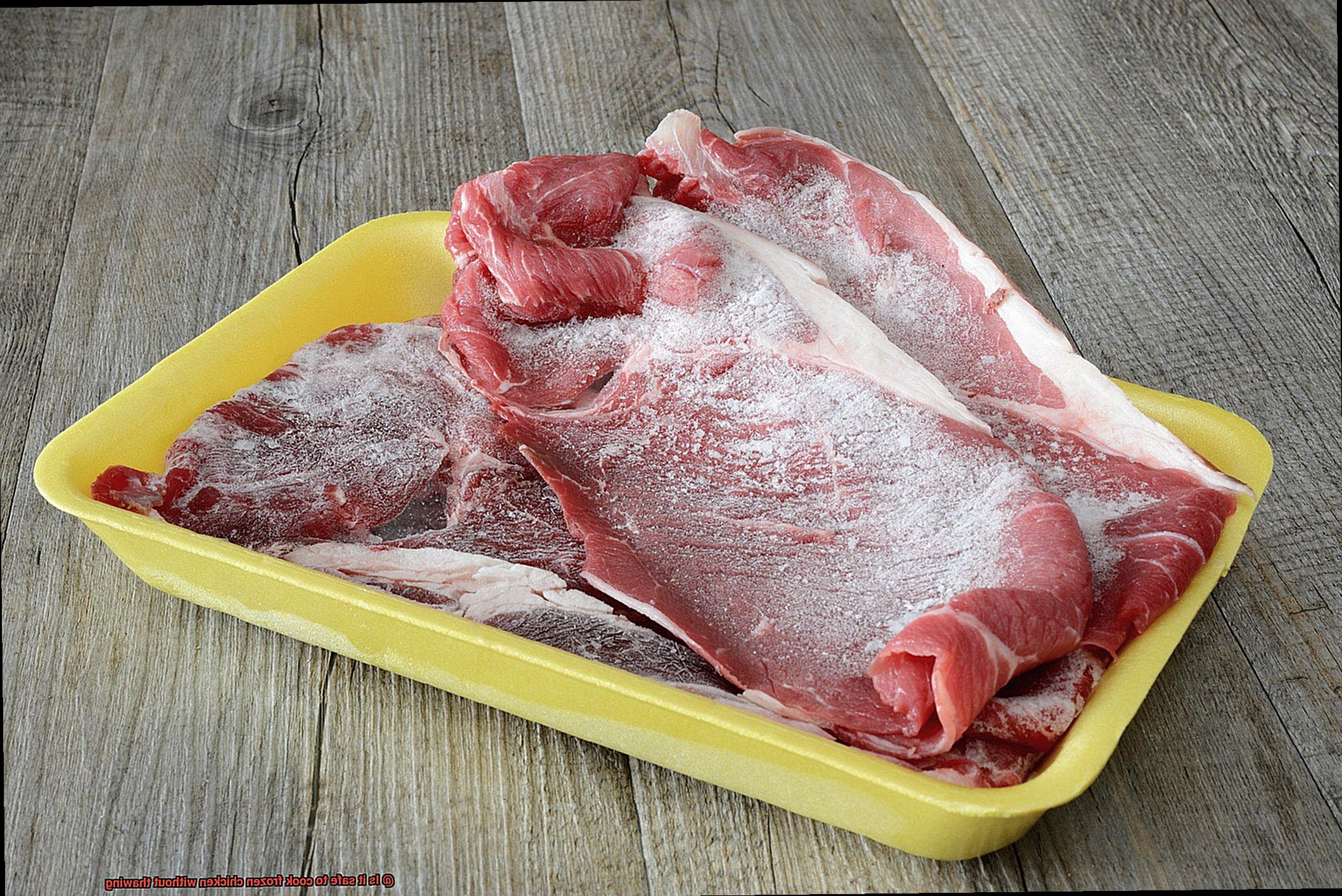
Foods That Go Well with Cooked Frozen Chicken
Cooking frozen chicken is a convenient and time-saving option, but it doesn’t have to be bland or boring. Pairing cooked frozen chicken with the right foods can elevate its taste and nutritional value.
One excellent way to serve cooked frozen chicken is to pair it with a variety of vegetables. Grilling frozen chicken and serving it with roasted vegetables like potatoes, carrots, and broccoli not only adds color and texture to the dish but also provides essential nutrients like fiber, vitamins, and minerals. The roasting process brings out the veggies’ natural sweetness and adds depth of flavor to the meal.
Grains like rice or quinoa are also fantastic accompaniments to cooked frozen chicken. They’re easy to prepare and can be flavored with herbs and spices to complement the chicken. For example, brown rice cooked with garlic and ginger creates an Asian-inspired dish that pairs perfectly with grilled frozen chicken.
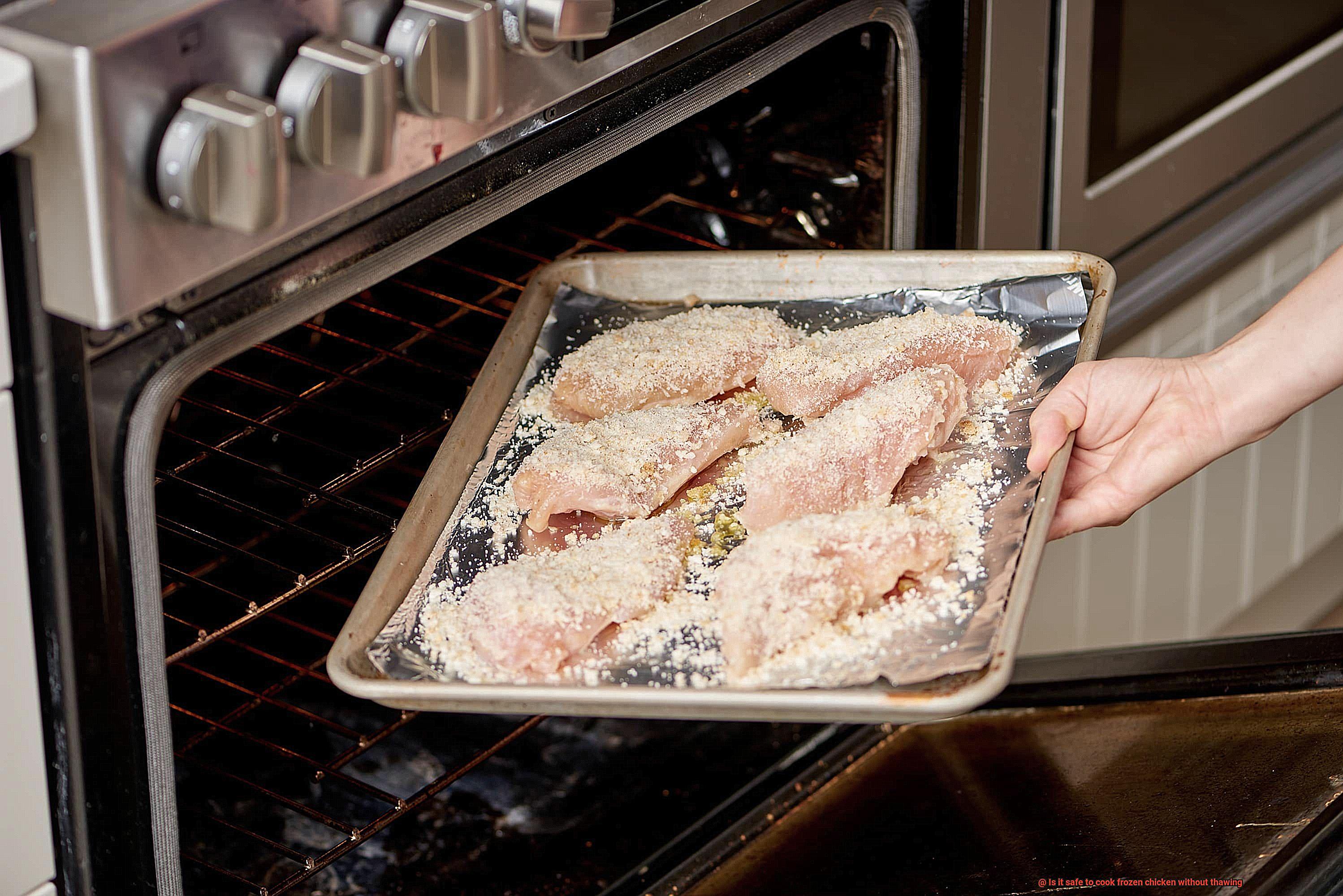
Salads are another great option for pairing with cooked frozen chicken. A simple side salad made with fresh greens like spinach or arugula, topped with diced tomatoes, cucumbers, and a light dressing can add a refreshing burst of flavor to any dish.
When it comes to pairing cooked frozen chicken with other foods, it’s crucial to consider the chicken’s flavor profile. If seasoned with spices like cumin or chili powder, pairing it with Mexican-style sides like beans and rice would be a perfect fit. Similarly, if marinated in lemon juice and garlic, serving it with Mediterranean-style sides like hummus or tabbouleh would be an excellent choice.
V9bUhkcbitk” >
Conclusion
In conclusion, cooking frozen chicken straight from the freezer is a safe and convenient option for those busy weeknights or forgetful moments. However, it’s crucial to take extra safety measures to avoid any potential health risks. When cooking frozen chicken, it’s essential to give it more time and attention to ensure that it reaches the recommended safe temperature of 165°F. Additionally, cross-contamination should be avoided by using separate cutting boards and utensils for raw and cooked foods.
The benefits of cooking frozen chicken are numerous, including saving time, retaining moisture in the meat for juicier and more flavorful results, and reducing the risk of harmful bacterial growth. Nevertheless, there are some potential risks such as uneven cooking and excess water being released from the meat.
To prepare frozen chicken safely for cooking, proper storage at 0°F or lower is critical. Thawing methods include using the refrigerator overnight or defrost function on your microwave. Before cooking with different methods like baking, grilling or frying, rinse and season your chicken.
Tips for ensuring safe internal temperatures when cooking frozen chicken include using a meat thermometer, choosing an even heat distribution method, marinating or seasoning your chicken before cooking and allowing enough time for cooking.
Common mistakes to avoid when cooking frozen chicken include not seasoning or marinating the chicken properly before cooking, overcrowding the pan while cooking which can lead to uneven heating and not checking the internal temperature with a meat thermometer which can lead to undercooked or overcooked results.
Finally, pairing cooked frozen chicken with vegetables like roasted potatoes or carrots adds color and texture to your dish while providing essential nutrients. Grains like rice or quinoa are also great accompaniments along with salads made with fresh greens like spinach or arugula.

